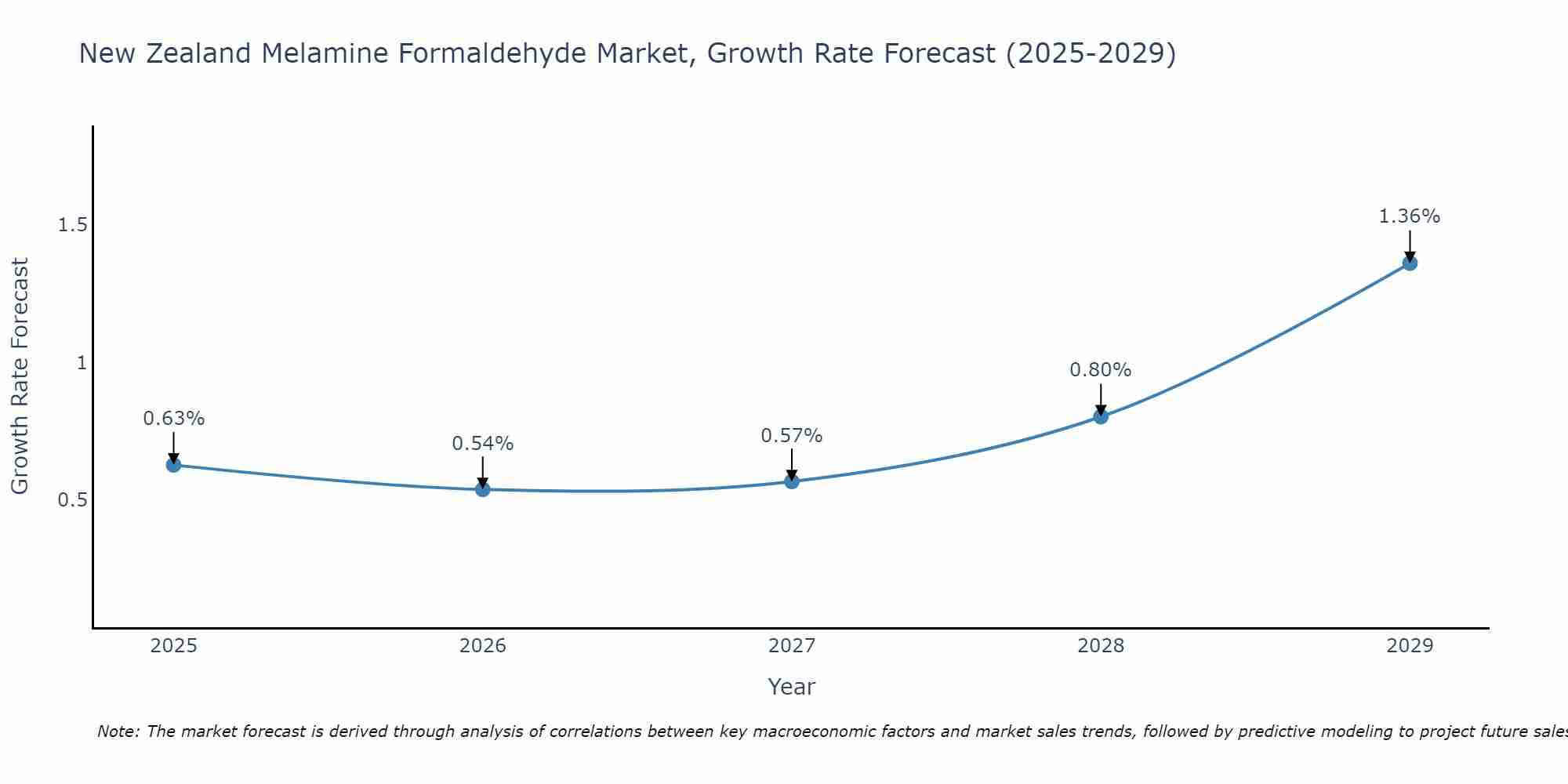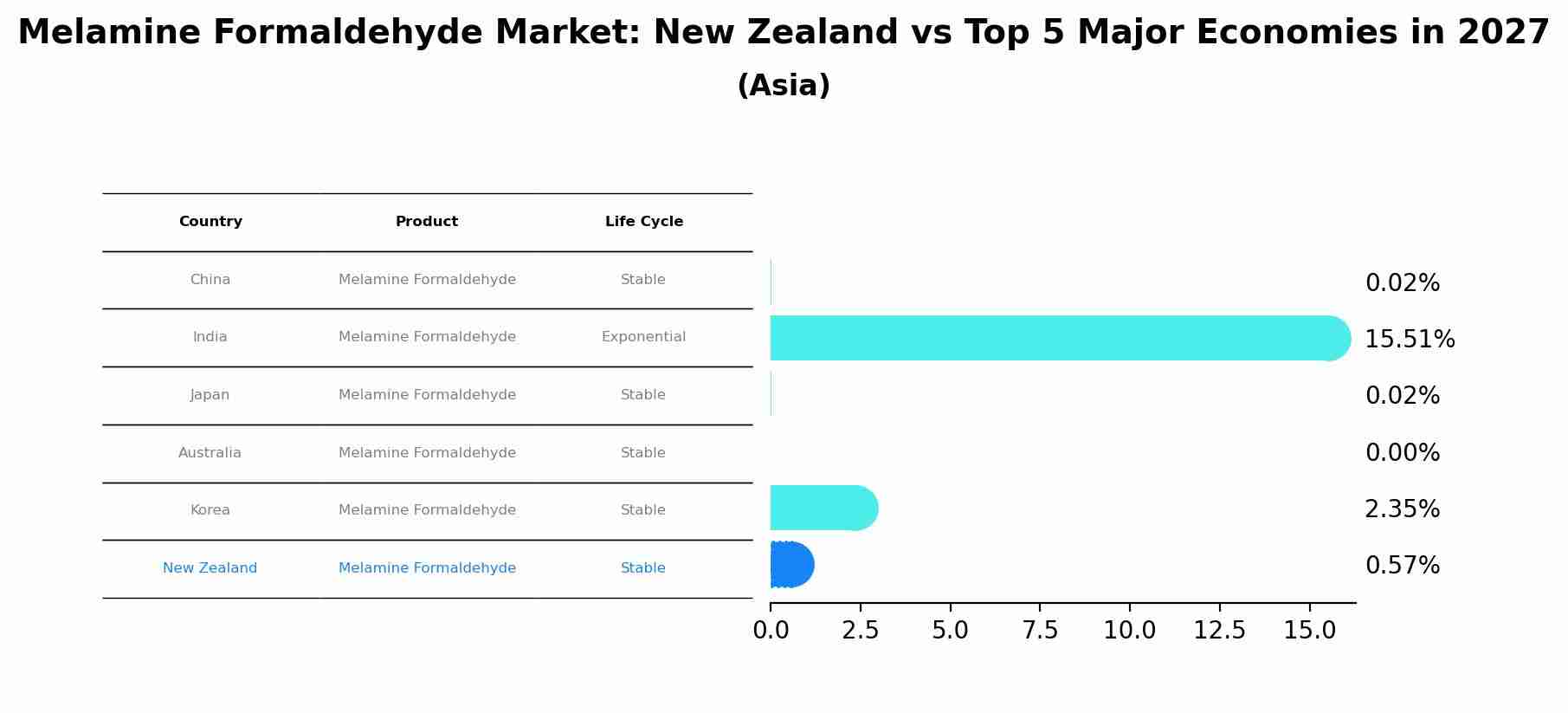New Zealand Melamine Formaldehyde Market (2025-2031) | Share, Value, Size, Companies, Trends, Revenue, Analysis, Industry, Growth, Outlook, Segmentation & Forecast
| Product Code: ETC4742060 | Publication Date: Nov 2023 | Updated Date: Sep 2025 | Product Type: Market Research Report | |
| Publisher: 6Wresearch | Author: Shubham Deep | No. of Pages: 60 | No. of Figures: 30 | No. of Tables: 5 |
New Zealand Melamine Formaldehyde Market Size Growth Rate
The New Zealand Melamine Formaldehyde Market is projected to witness mixed growth rate patterns during 2025 to 2029. Commencing at 0.63% in 2025, growth builds up to 1.36% by 2029.

Melamine Formaldehyde Market: New Zealand vs Top 5 Major Economies in 2027 (Asia)
By 2027, New Zealand's Melamine Formaldehyde market is forecasted to achieve a stable growth rate of 0.57%, with China leading the Asia region, followed by India, Japan, Australia and South Korea.

New Zealand Melamine Formaldehyde Market Overview
The melamine formaldehyde market in New Zealand encompasses a range of products used in various applications, including laminates, coatings, adhesives, and molded products. Melamine formaldehyde resins offer properties such as durability, heat resistance, and dimensional stability, making them suitable for diverse industrial and consumer applications. With a focus on sustainability and environmental regulations, manufacturers are developing bio-based and formaldehyde-free alternatives to traditional melamine formaldehyde resins, driving innovation in this market segment.
Drivers of the market
The melamine formaldehyde market in New Zealand is driven by the construction and automotive industries` demand for durable and lightweight materials. Melamine formaldehyde resins find extensive applications in laminates, decorative surfaces, coatings, and adhesives due to their high heat resistance, chemical stability, and mechanical strength. Moreover, the growing focus on sustainable and eco-friendly materials fuels the demand for melamine formaldehyde-based products in New Zealand, driving market growth.
Challenges of the market
In the **New Zealand Melamine Formaldehyde Market**, challenges include ensuring product quality and safety in applications such as laminates, adhesives, and coatings, while addressing concerns regarding formaldehyde emissions and environmental sustainability. Regulatory compliance with standards such as the European Union`s REACH regulation drives demand for alternative formulations and manufacturing processes.
Government Policy of the market
Environmental regulations on chemical manufacturing and support for sustainable practices impact the melamine formaldehyde market. Trade policies and import regulations also play a significant role.
Key Highlights of the Report:
- New Zealand Melamine Formaldehyde Market Outlook
- Market Size of New Zealand Melamine Formaldehyde Market, 2024
- Forecast of New Zealand Melamine Formaldehyde Market, 2031
- Historical Data and Forecast of New Zealand Melamine Formaldehyde Revenues & Volume for the Period 2021-2031
- New Zealand Melamine Formaldehyde Market Trend Evolution
- New Zealand Melamine Formaldehyde Market Drivers and Challenges
- New Zealand Melamine Formaldehyde Price Trends
- New Zealand Melamine Formaldehyde Porter`s Five Forces
- New Zealand Melamine Formaldehyde Industry Life Cycle
- Historical Data and Forecast of New Zealand Melamine Formaldehyde Market Revenues & Volume By Type for the Period 2021-2031
- Historical Data and Forecast of New Zealand Melamine Formaldehyde Market Revenues & Volume By Methylated Melamine Formaldehyde Resin for the Period 2021-2031
- Historical Data and Forecast of New Zealand Melamine Formaldehyde Market Revenues & Volume By Non-methylated Melamine Formaldehyde Resin for the Period 2021-2031
- Historical Data and Forecast of New Zealand Melamine Formaldehyde Market Revenues & Volume By Application for the Period 2021-2031
- Historical Data and Forecast of New Zealand Melamine Formaldehyde Market Revenues & Volume By Laminates for the Period 2021-2031
- Historical Data and Forecast of New Zealand Melamine Formaldehyde Market Revenues & Volume By Wood Adhesives for the Period 2021-2031
- Historical Data and Forecast of New Zealand Melamine Formaldehyde Market Revenues & Volume By Molding Compounds for the Period 2021-2031
- Historical Data and Forecast of New Zealand Melamine Formaldehyde Market Revenues & Volume By Paints and Coatings for the Period 2021-2031
- Historical Data and Forecast of New Zealand Melamine Formaldehyde Market Revenues & Volume By Other Applications for the Period 2021-2031
- New Zealand Melamine Formaldehyde Import Export Trade Statistics
- Market Opportunity Assessment By Type
- Market Opportunity Assessment By Application
- New Zealand Melamine Formaldehyde Top Companies Market Share
- New Zealand Melamine Formaldehyde Competitive Benchmarking By Technical and Operational Parameters
- New Zealand Melamine Formaldehyde Company Profiles
- New Zealand Melamine Formaldehyde Key Strategic Recommendations
Frequently Asked Questions About the Market Study (FAQs):
1 Executive Summary |
2 Introduction |
2.1 Key Highlights of the Report |
2.2 Report Description |
2.3 Market Scope & Segmentation |
2.4 Research Methodology |
2.5 Assumptions |
3 New Zealand Melamine Formaldehyde Market Overview |
3.1 New Zealand Country Macro Economic Indicators |
3.2 New Zealand Melamine Formaldehyde Market Revenues & Volume, 2021 & 2031F |
3.3 New Zealand Melamine Formaldehyde Market - Industry Life Cycle |
3.4 New Zealand Melamine Formaldehyde Market - Porter's Five Forces |
3.5 New Zealand Melamine Formaldehyde Market Revenues & Volume Share, By Type, 2021 & 2031F |
3.6 New Zealand Melamine Formaldehyde Market Revenues & Volume Share, By Application, 2021 & 2031F |
4 New Zealand Melamine Formaldehyde Market Dynamics |
4.1 Impact Analysis |
4.2 Market Drivers |
4.2.1 Increasing demand for sustainable and eco-friendly materials in construction and furniture industries |
4.2.2 Growing investments in infrastructure development projects in New Zealand |
4.2.3 Rising awareness about the benefits of melamine formaldehyde products in various applications |
4.3 Market Restraints |
4.3.1 Fluctuating prices of raw materials such as formaldehyde and urea |
4.3.2 Stringent regulations related to environmental impact and health concerns |
4.3.3 Competition from alternative materials like PVC and phenolic resins |
5 New Zealand Melamine Formaldehyde Market Trends |
6 New Zealand Melamine Formaldehyde Market Segmentations |
6.1 New Zealand Melamine Formaldehyde Market, By Type |
6.1.1 Overview and Analysis |
6.1.2 New Zealand Melamine Formaldehyde Market Revenues & Volume, By Methylated Melamine Formaldehyde Resin, 2021-2031F |
6.1.3 New Zealand Melamine Formaldehyde Market Revenues & Volume, By Non-methylated Melamine Formaldehyde Resin, 2021-2031F |
6.2 New Zealand Melamine Formaldehyde Market, By Application |
6.2.1 Overview and Analysis |
6.2.2 New Zealand Melamine Formaldehyde Market Revenues & Volume, By Laminates, 2021-2031F |
6.2.3 New Zealand Melamine Formaldehyde Market Revenues & Volume, By Wood Adhesives, 2021-2031F |
6.2.4 New Zealand Melamine Formaldehyde Market Revenues & Volume, By Molding Compounds, 2021-2031F |
6.2.5 New Zealand Melamine Formaldehyde Market Revenues & Volume, By Paints and Coatings, 2021-2031F |
6.2.6 New Zealand Melamine Formaldehyde Market Revenues & Volume, By Other Applications, 2021-2031F |
7 New Zealand Melamine Formaldehyde Market Import-Export Trade Statistics |
7.1 New Zealand Melamine Formaldehyde Market Export to Major Countries |
7.2 New Zealand Melamine Formaldehyde Market Imports from Major Countries |
8 New Zealand Melamine Formaldehyde Market Key Performance Indicators |
8.1 Percentage of melamine formaldehyde products used in new construction projects |
8.2 Number of infrastructure projects utilizing melamine formaldehyde materials |
8.3 Adoption rate of melamine formaldehyde in new application areas |
9 New Zealand Melamine Formaldehyde Market - Opportunity Assessment |
9.1 New Zealand Melamine Formaldehyde Market Opportunity Assessment, By Type, 2021 & 2031F |
9.2 New Zealand Melamine Formaldehyde Market Opportunity Assessment, By Application, 2021 & 2031F |
10 New Zealand Melamine Formaldehyde Market - Competitive Landscape |
10.1 New Zealand Melamine Formaldehyde Market Revenue Share, By Companies, 2024 |
10.2 New Zealand Melamine Formaldehyde Market Competitive Benchmarking, By Operating and Technical Parameters |
11 Company Profiles |
12 Recommendations | 13 Disclaimer |
- Single User License$ 1,995
- Department License$ 2,400
- Site License$ 3,120
- Global License$ 3,795
Search
Related Reports
- ASEAN and Thailand Brain Health Supplements Market (2025-2031) | Strategy, Consumer Insights, Analysis, Investment Trends, Opportunities, Growth, Size, Share, Industry, Revenue, Segments, Value, Segmentation, Supply, Forecast, Restraints, Outlook, Competition, Drivers, Trends, Demand, Pricing Analysis, Competitive, Strategic Insights, Companies, Challenges
- ASEAN Bearings Market (2025-2031) | Strategy, Consumer Insights, Analysis, Investment Trends, Opportunities, Growth, Size, Share, Industry, Revenue, Segments, Value, Segmentation, Supply, Forecast, Restraints, Outlook, Competition, Drivers, Trends, Demand, Pricing Analysis, Competitive, Strategic Insights, Companies, Challenges
- Europe Flooring Market (2025-2031) | Outlook, Share, Industry, Trends, Forecast, Companies, Revenue, Size, Analysis, Growth & Value
- Saudi Arabia Manlift Market (2025-2031) | Outlook, Size, Growth, Trends, Companies, Industry, Revenue, Value, Share, Forecast & Analysis
- Uganda Excavator, Crane, and Wheel Loaders Market (2025-2031) | Strategy, Consumer Insights, Analysis, Investment Trends, Opportunities, Growth, Size, Share, Industry, Revenue, Segments, Value, Segmentation, Supply, Forecast, Restraints, Outlook, Competition, Drivers, Trends, Demand, Pricing Analysis, Competitive, Strategic Insights, Companies, Challenges
- Rwanda Excavator, Crane, and Wheel Loaders Market (2025-2031) | Strategy, Consumer Insights, Analysis, Investment Trends, Opportunities, Growth, Size, Share, Industry, Revenue, Segments, Value, Segmentation, Supply, Forecast, Restraints, Outlook, Competition, Drivers, Trends, Demand, Pricing Analysis, Competitive, Strategic Insights, Companies, Challenges
- Kenya Excavator, Crane, and Wheel Loaders Market (2025-2031) | Strategy, Consumer Insights, Analysis, Investment Trends, Opportunities, Growth, Size, Share, Industry, Revenue, Segments, Value, Segmentation, Supply, Forecast, Restraints, Outlook, Competition, Drivers, Trends, Demand, Pricing Analysis, Competitive, Strategic Insights, Companies, Challenges
- Angola Excavator, Crane, and Wheel Loaders Market (2025-2031) | Strategy, Consumer Insights, Analysis, Investment Trends, Opportunities, Growth, Size, Share, Industry, Revenue, Segments, Value, Segmentation, Supply, Forecast, Restraints, Outlook, Competition, Drivers, Trends, Demand, Pricing Analysis, Competitive, Strategic Insights, Companies, Challenges
- Israel Intelligent Transport System Market (2025-2031) | Strategy, Consumer Insights, Analysis, Investment Trends, Opportunities, Growth, Size, Share, Industry, Revenue, Segments, Value, Segmentation, Supply, Forecast, Restraints, Outlook, Competition, Drivers, Trends, Demand, Pricing Analysis, Competitive, Strategic Insights, Companies, Challenges
- Uganda Precast and Aggregate Market (2025-2031) | Strategy, Consumer Insights, Analysis, Investment Trends, Opportunities, Growth, Size, Share, Industry, Revenue, Segments, Value, Segmentation, Supply, Forecast, Restraints, Outlook, Competition, Drivers, Trends, Demand, Pricing Analysis, Competitive, Strategic Insights, Companies, Challenges
Industry Events and Analyst Meet
Our Clients
Whitepaper
- Middle East & Africa Commercial Security Market Click here to view more.
- Middle East & Africa Fire Safety Systems & Equipment Market Click here to view more.
- GCC Drone Market Click here to view more.
- Middle East Lighting Fixture Market Click here to view more.
- GCC Physical & Perimeter Security Market Click here to view more.
6WResearch In News
- Doha a strategic location for EV manufacturing hub: IPA Qatar
- Demand for luxury TVs surging in the GCC, says Samsung
- Empowering Growth: The Thriving Journey of Bangladesh’s Cable Industry
- Demand for luxury TVs surging in the GCC, says Samsung
- Video call with a traditional healer? Once unthinkable, it’s now common in South Africa
- Intelligent Buildings To Smooth GCC’s Path To Net Zero













